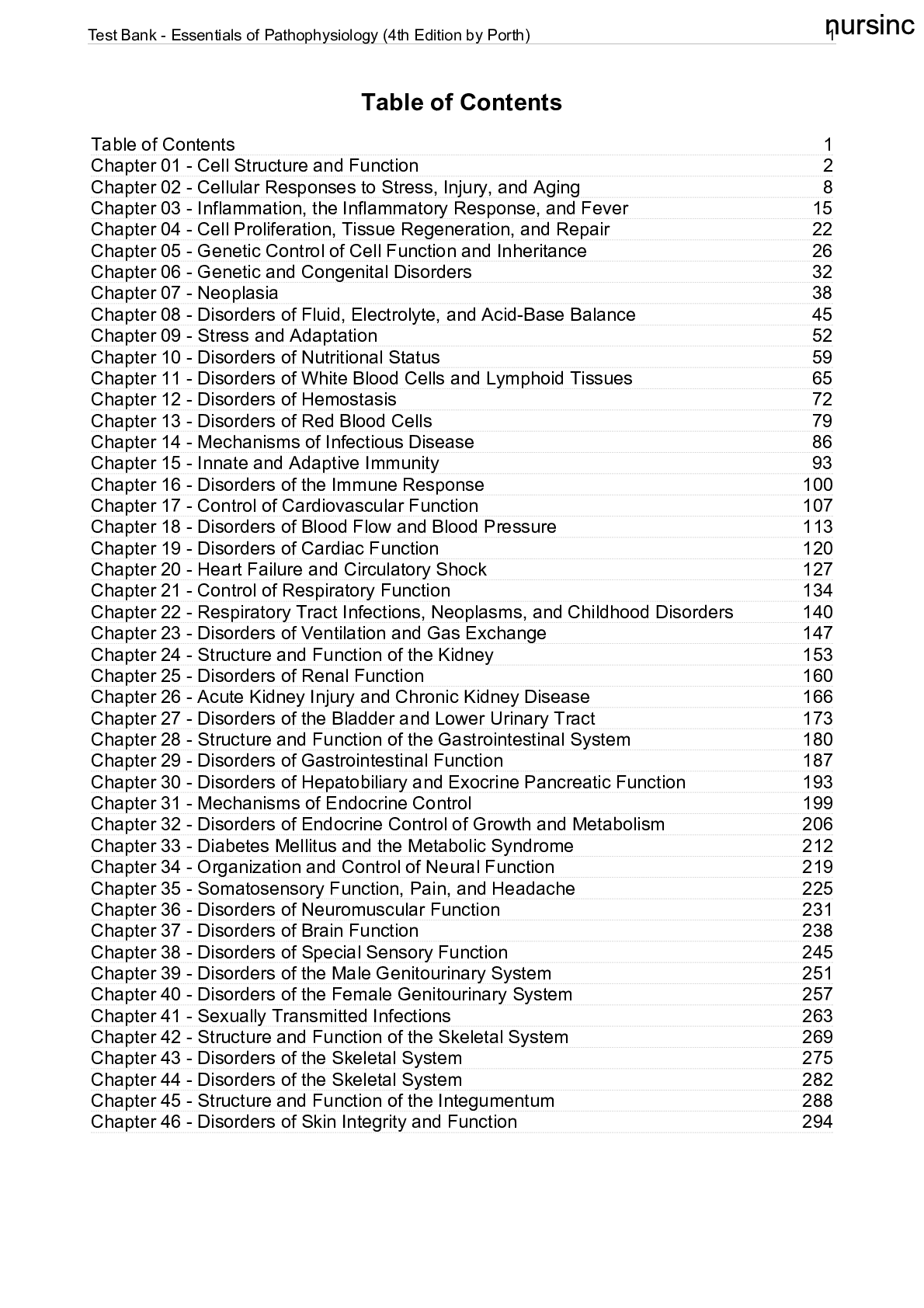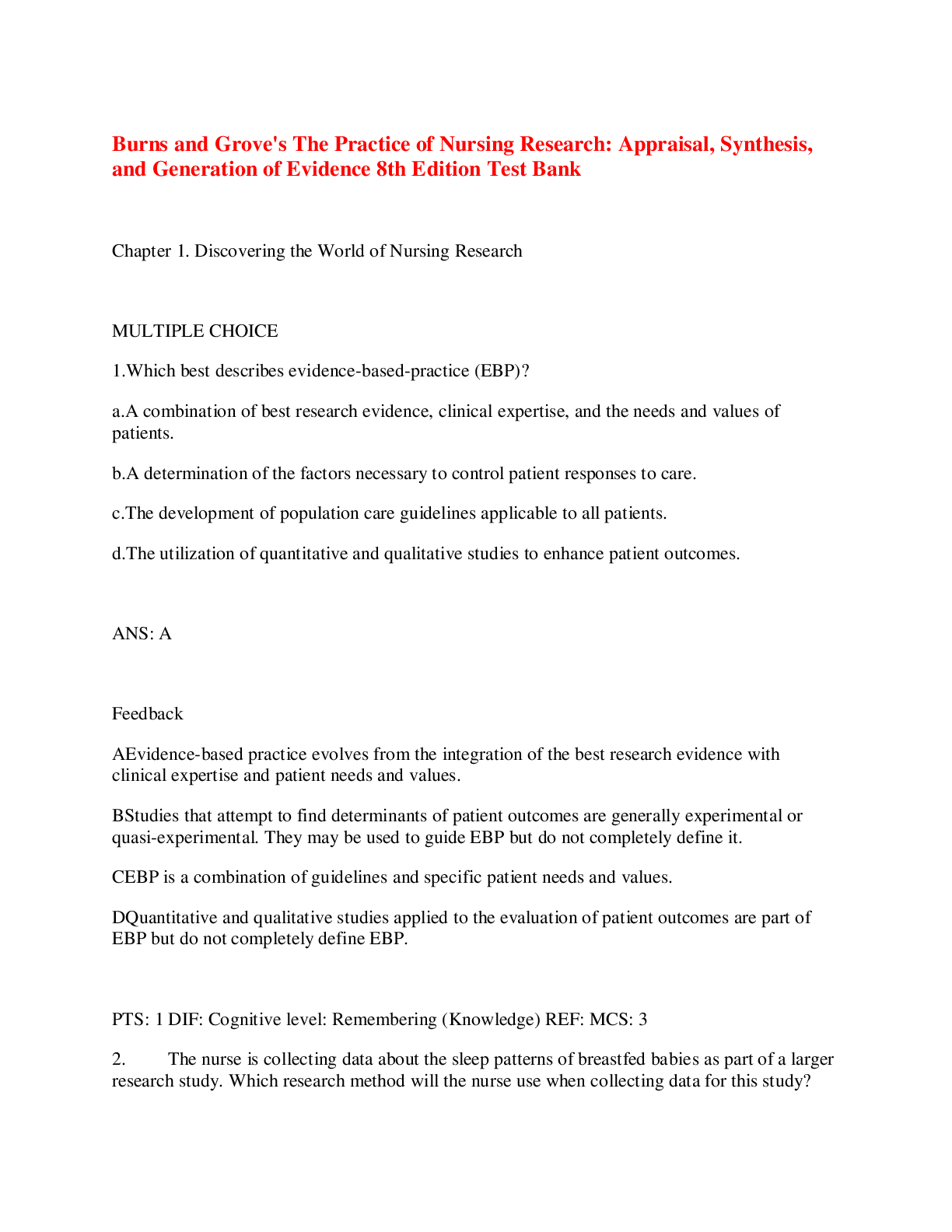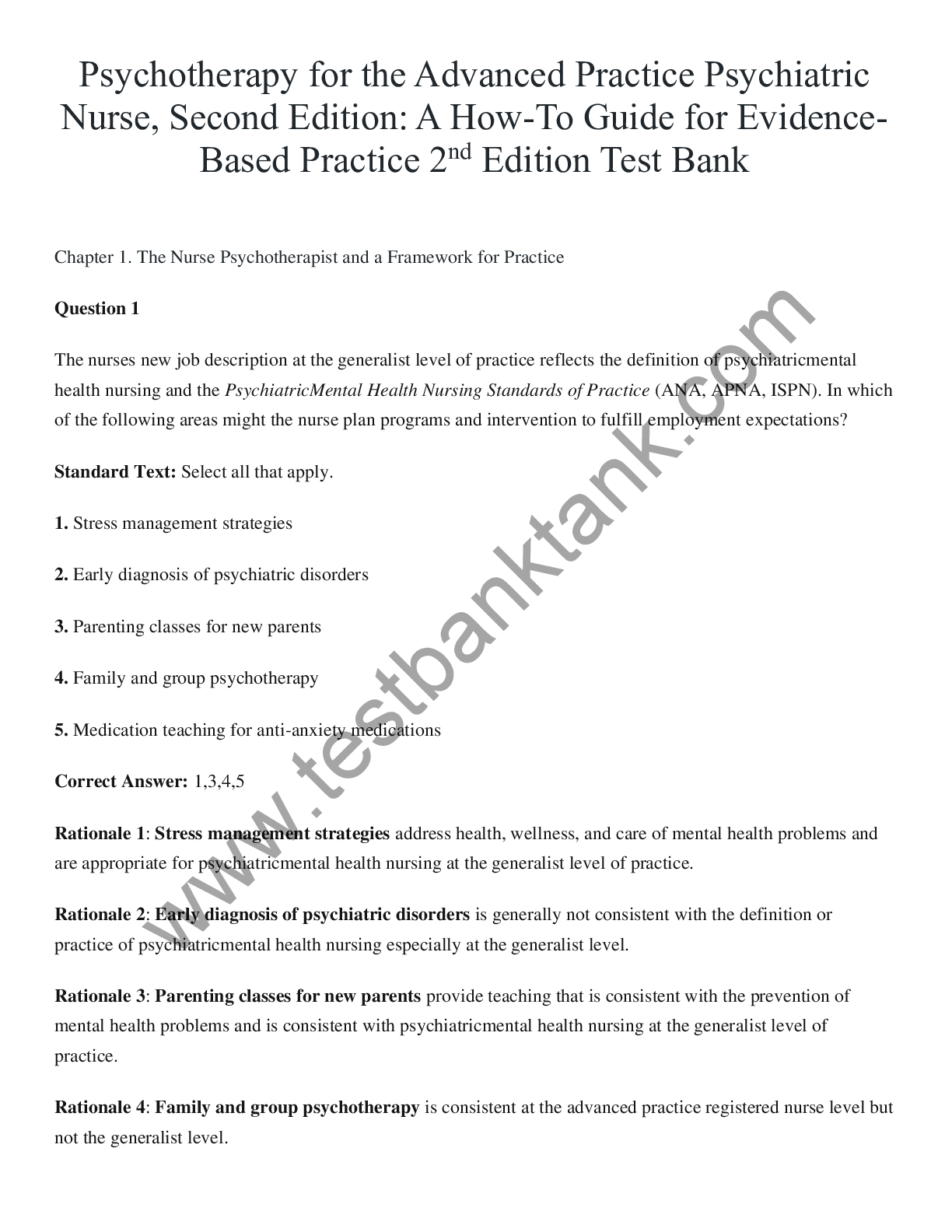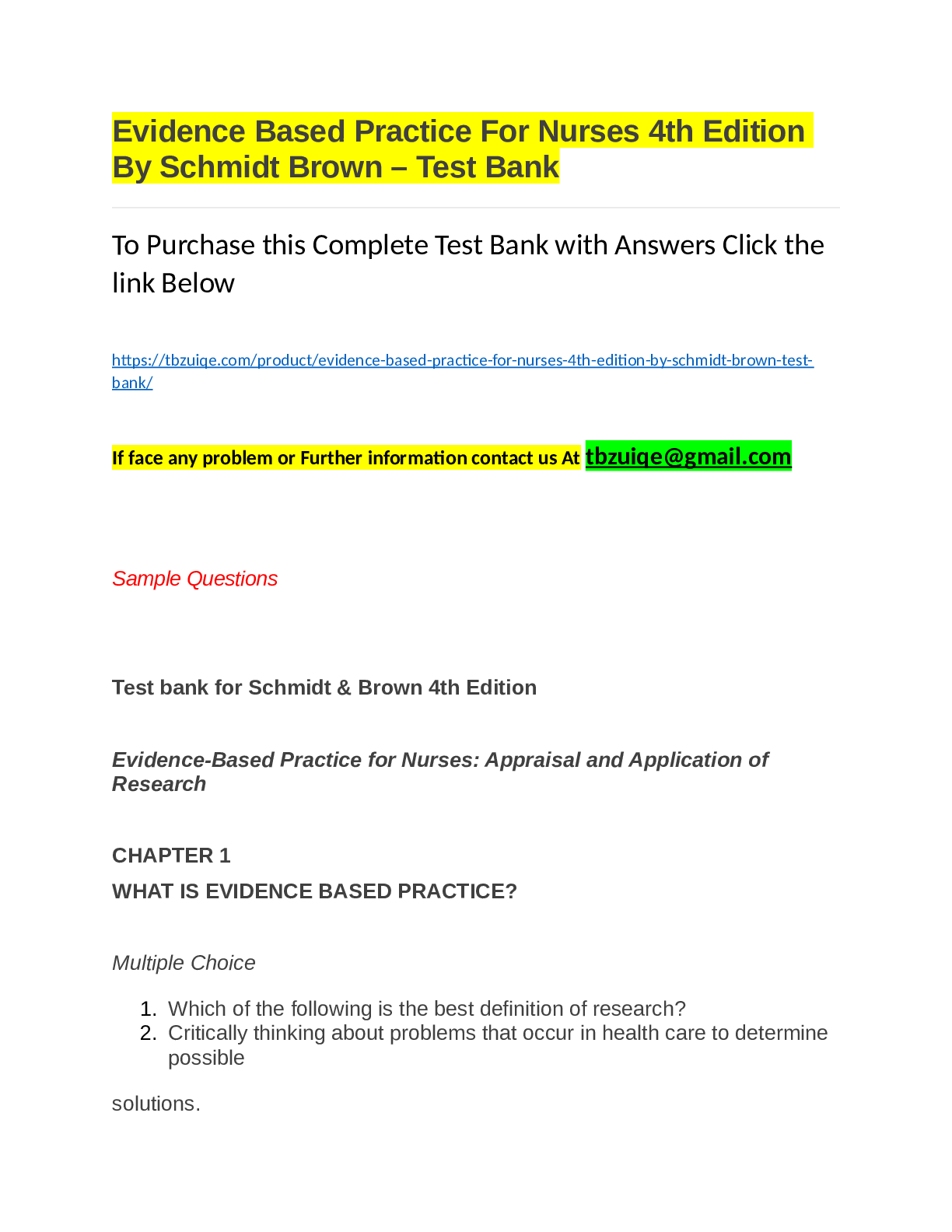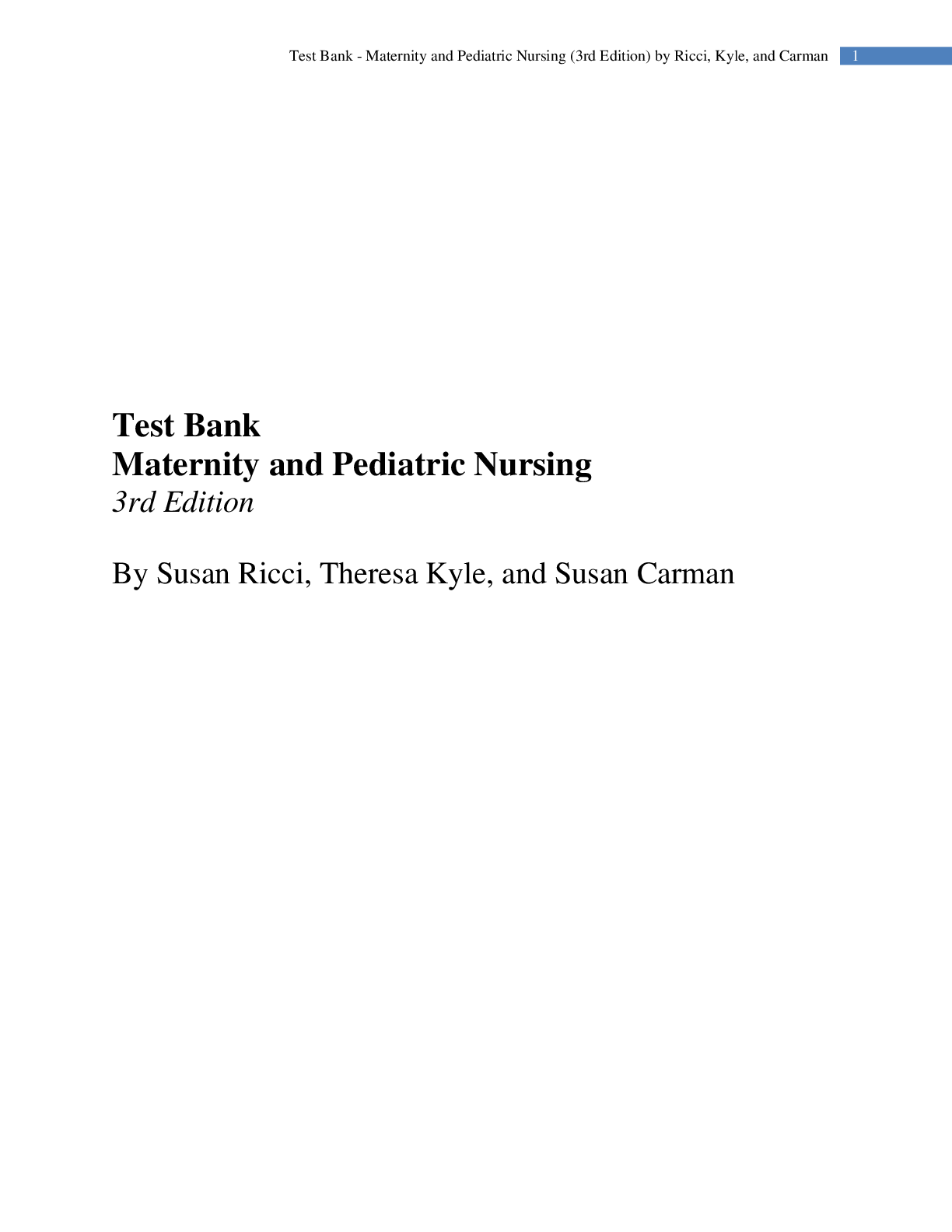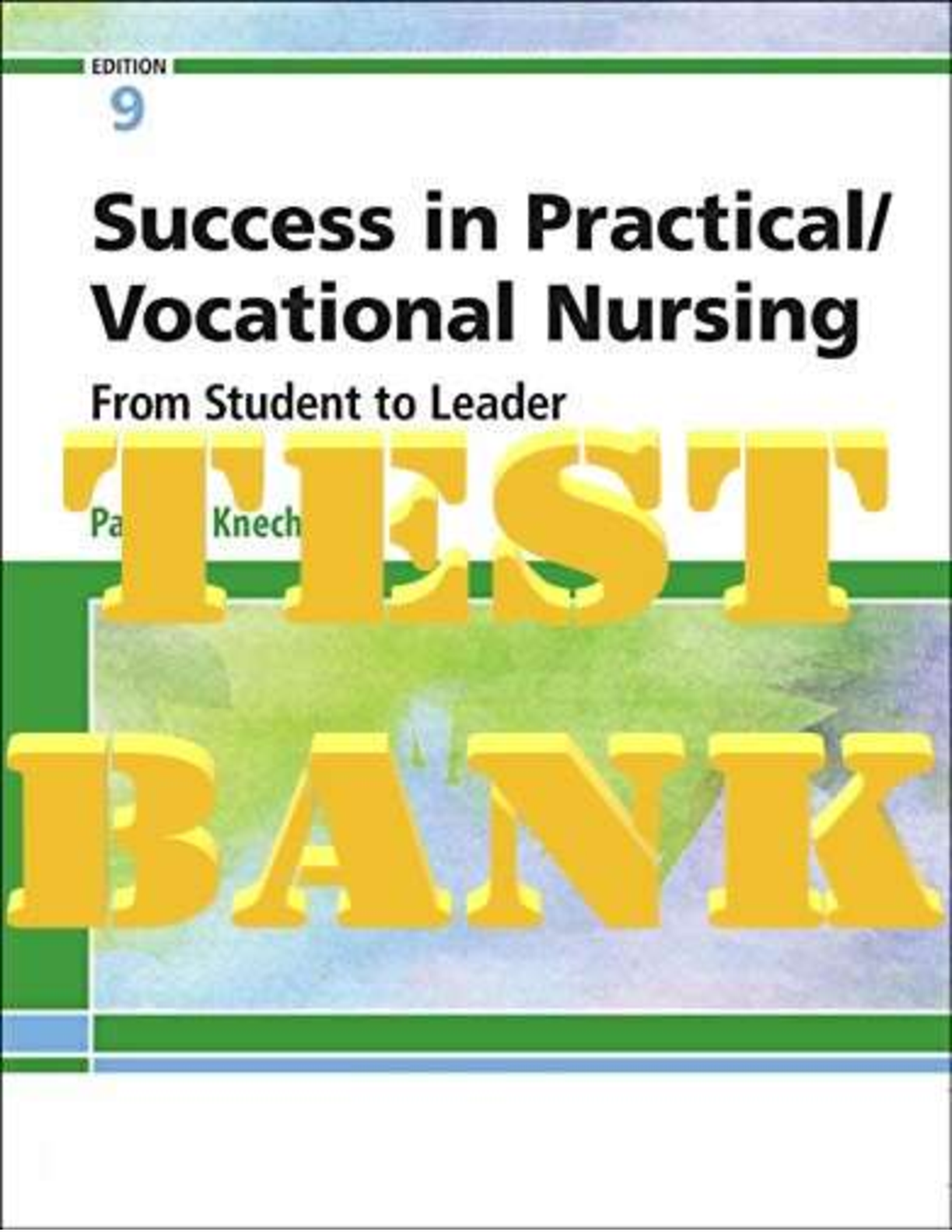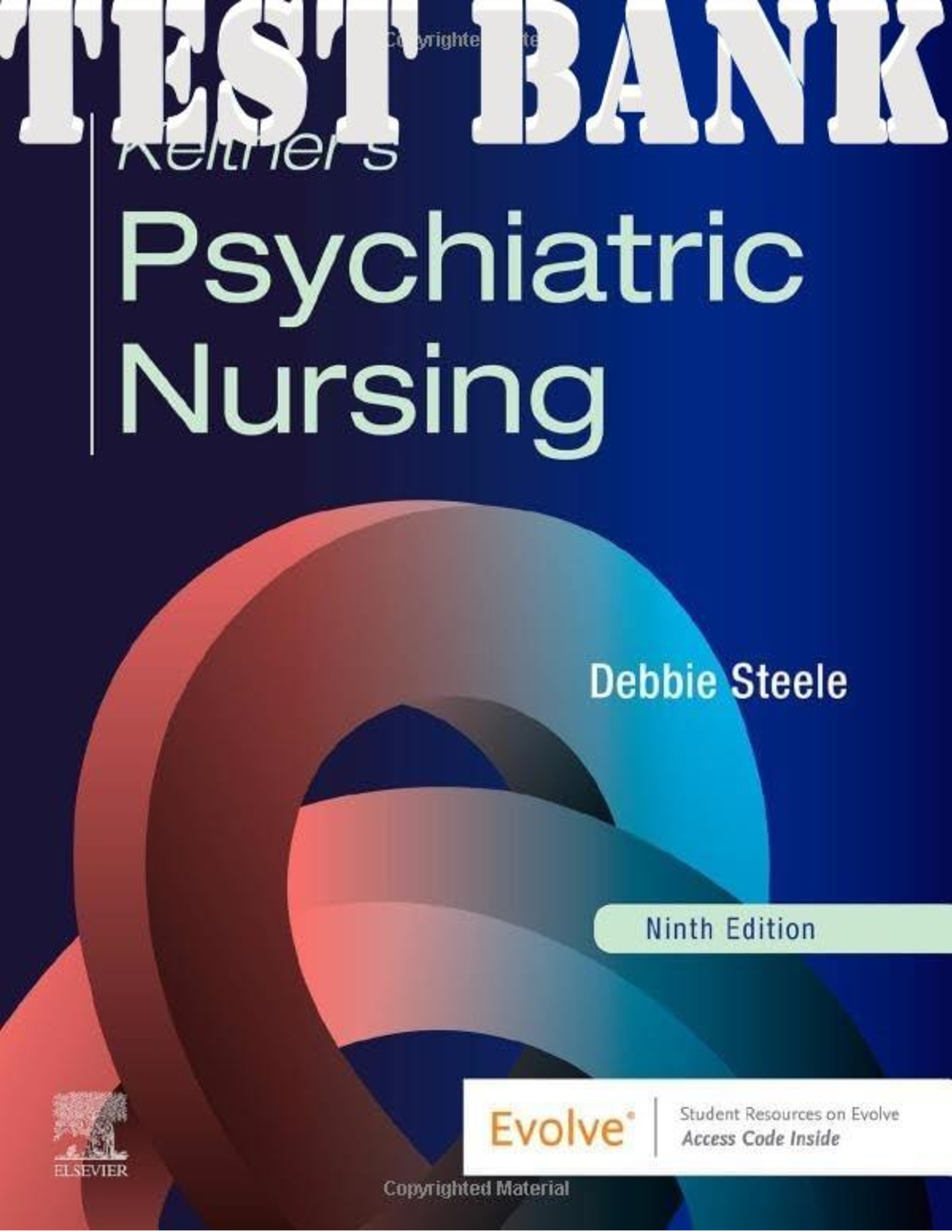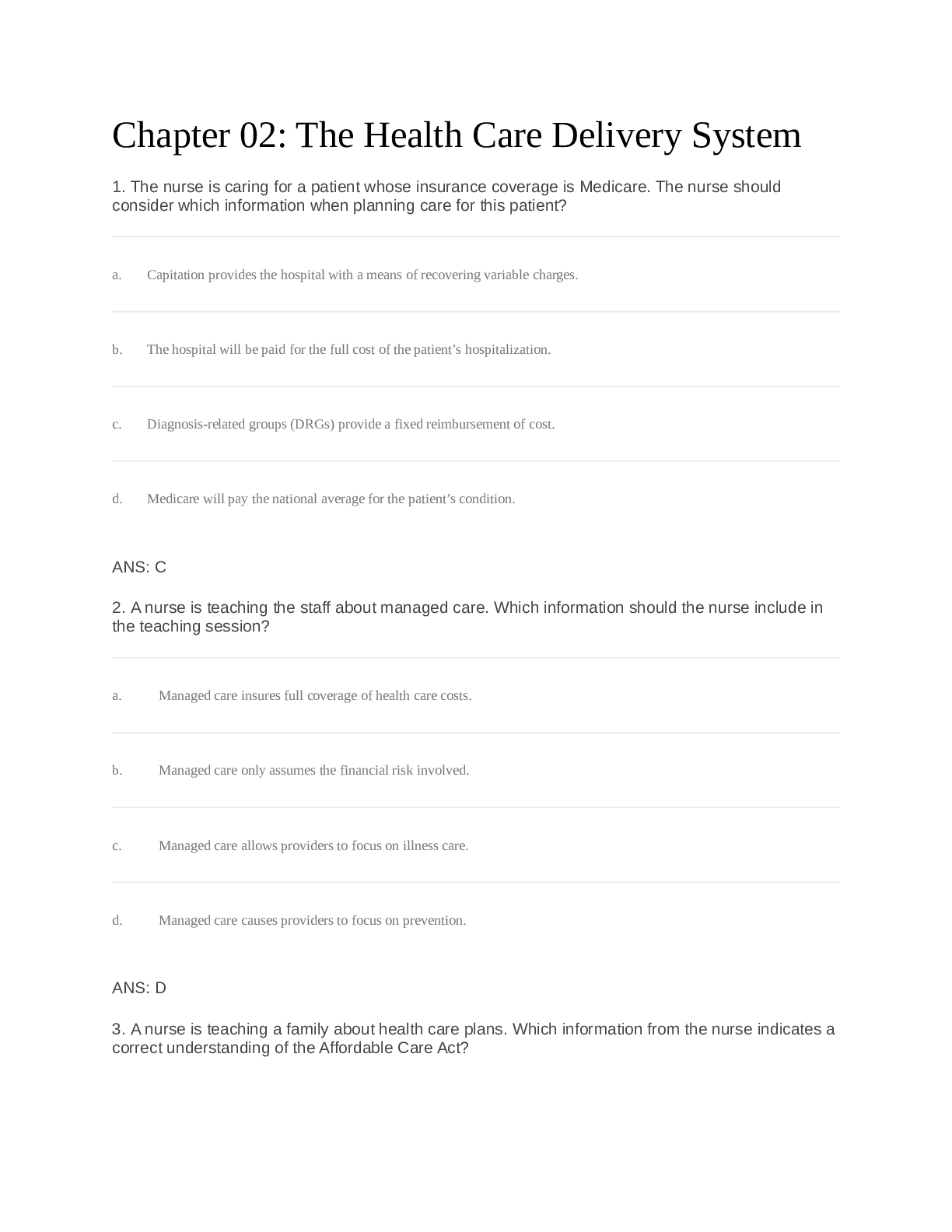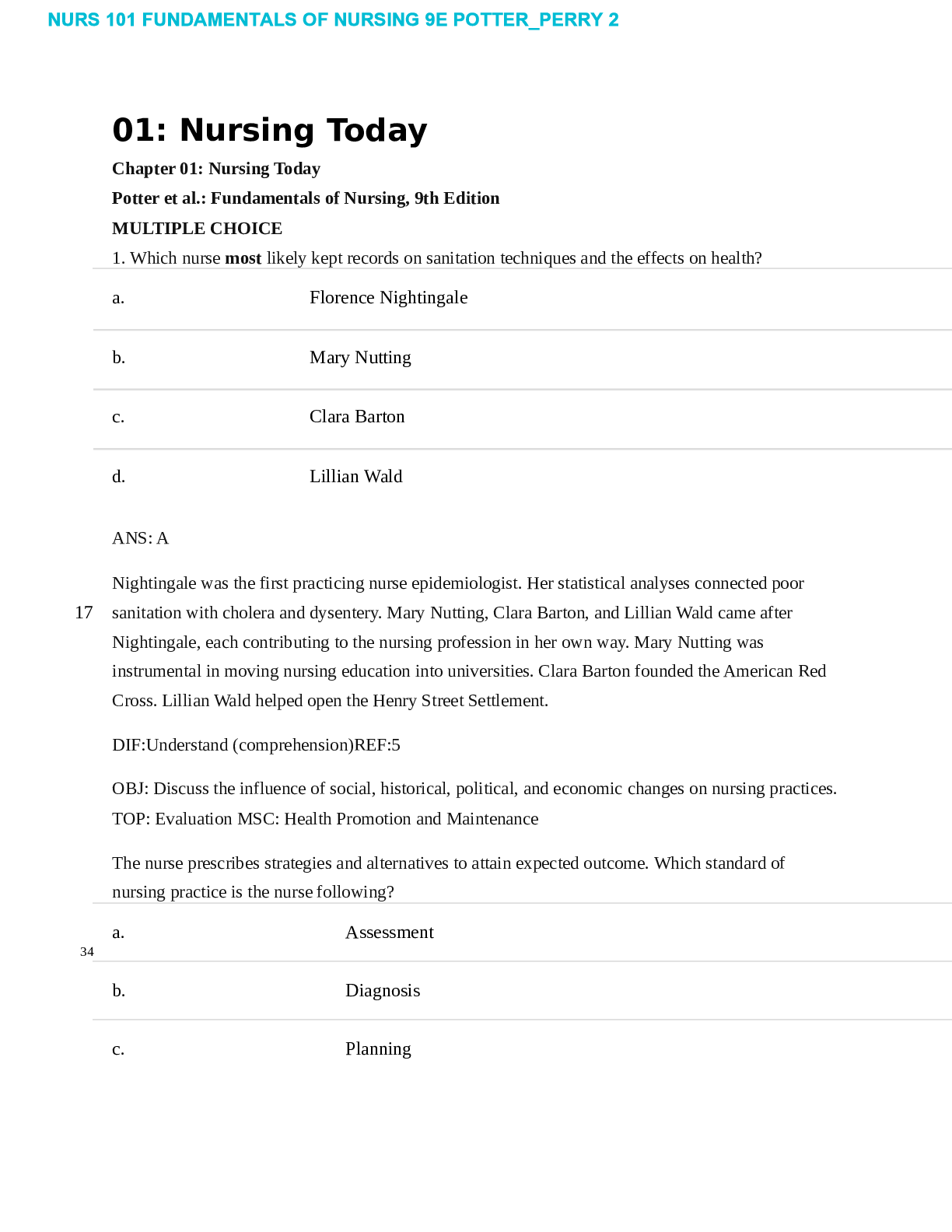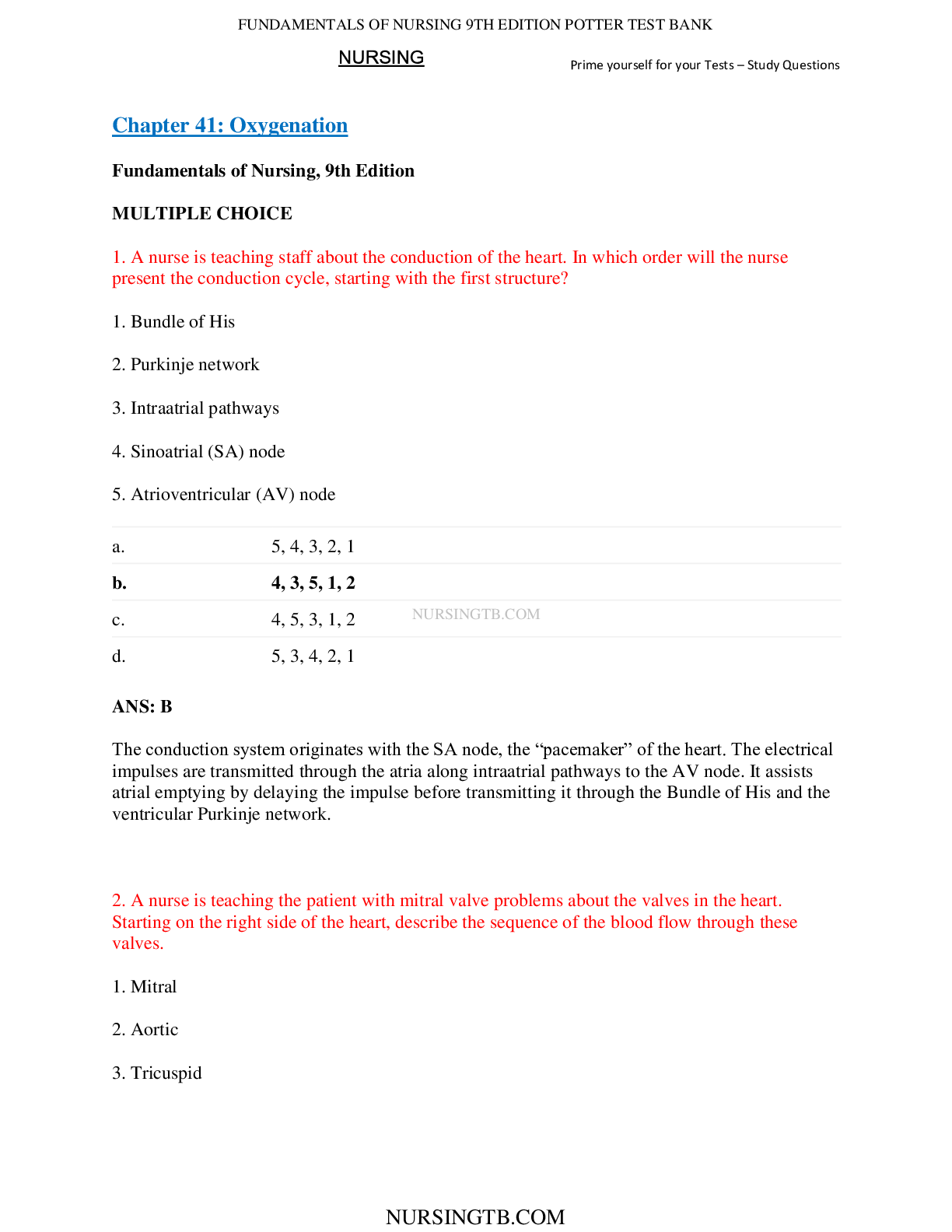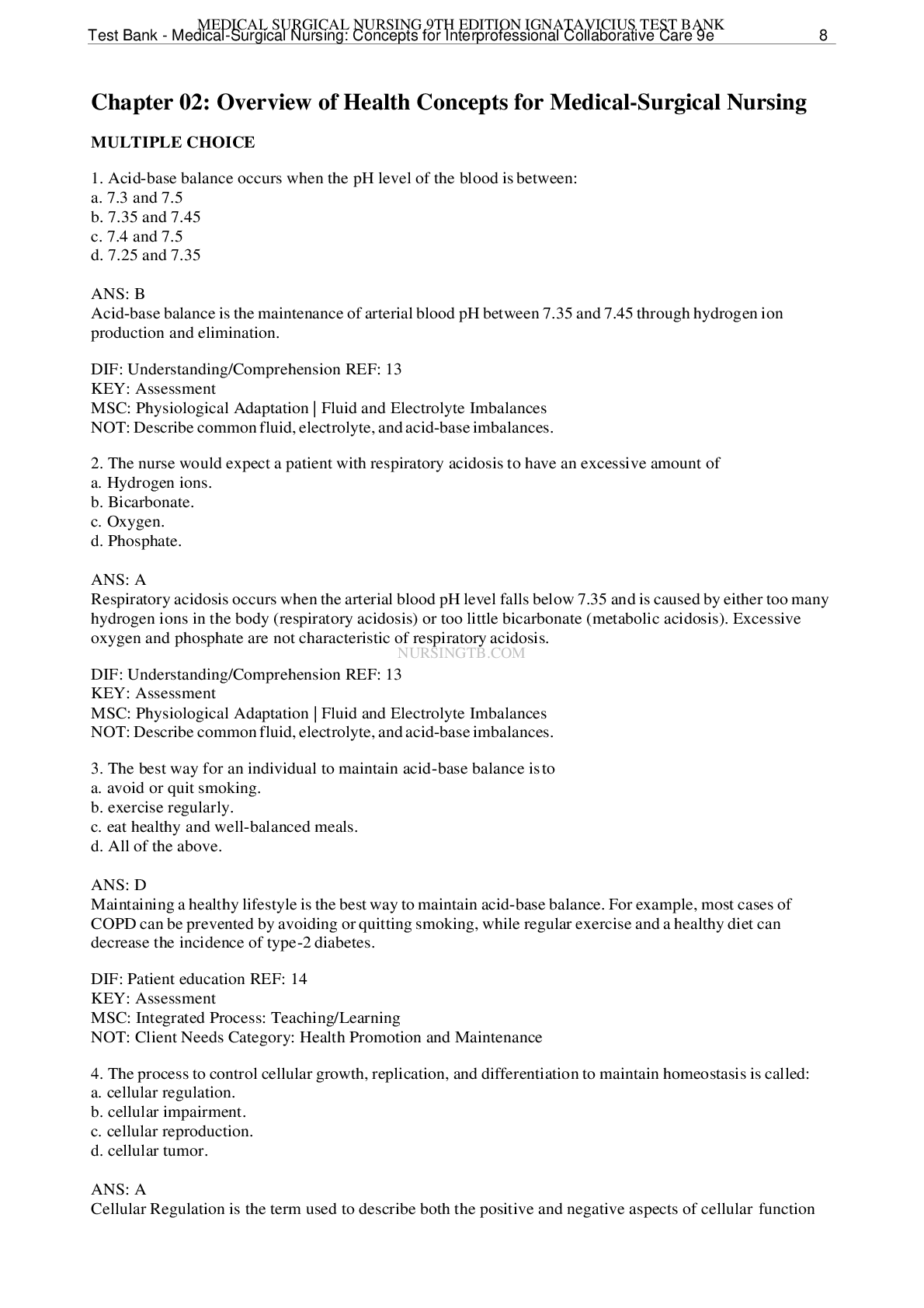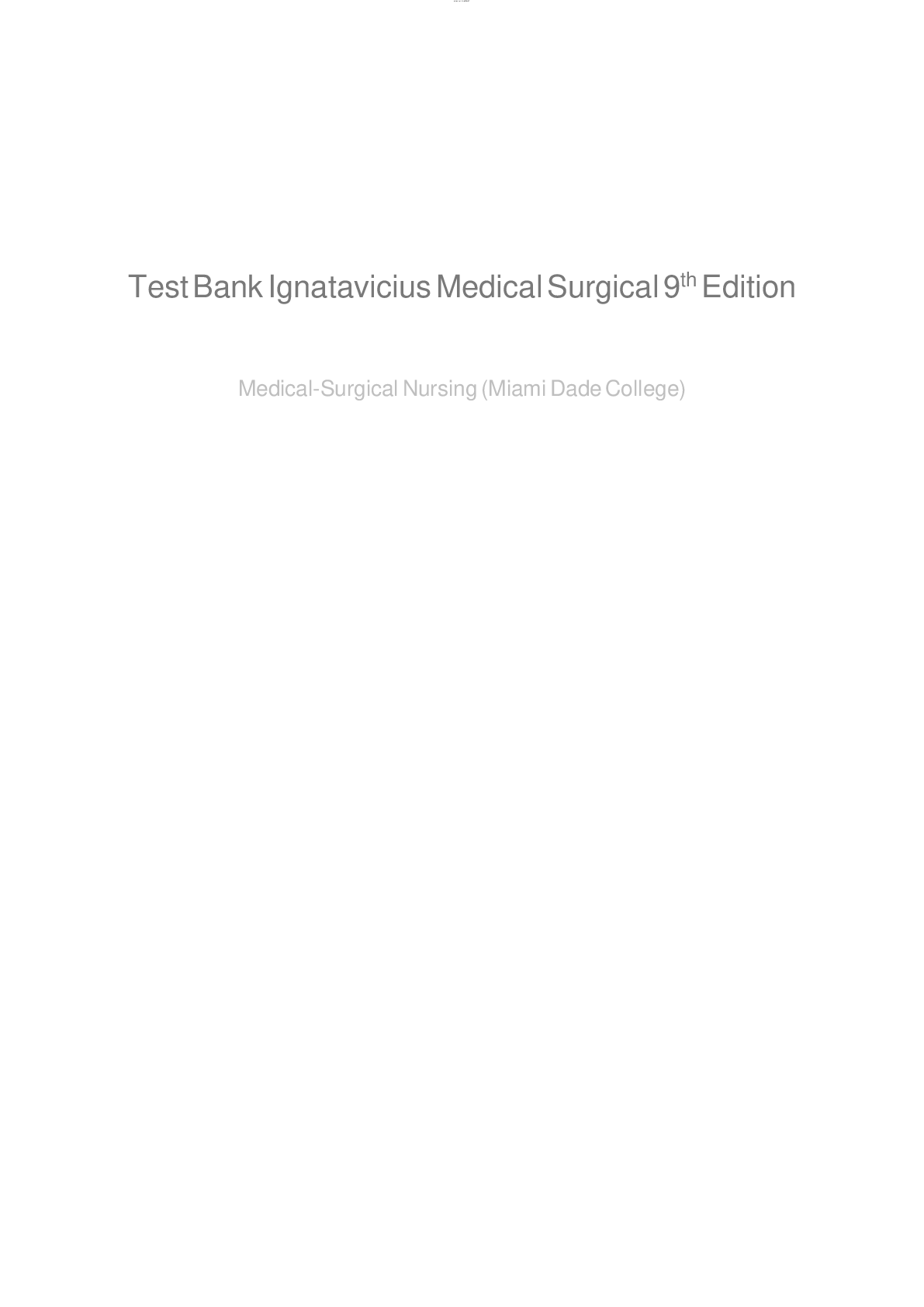Medical Surgical Nursing 9th Edition Ignatavicius Test Bank latest
Document Content and Description Below
Test Bank Ignatavicius Medical Surgical 9th 2017 Medical-Surgical Nursing (Miami Dade College)lOMoARcPSD|667 218 7 Test Bank - Medical-Surgical Nursing: Concepts for Interprofessional Collaborative ... Care 9e 1 Downloaded by Jamie Garvey ([email protected]) Table of Contents Table of Contents 1 Chapter 01: Overview of Professional Nursing Concepts for Medical-Surgical NursingChapter 02: Overview of Health Concepts for Medical-Surgical Nursing Chapter 03: Common Health Problems of Older Adults Chapter 04: Assessment and Care of Patients with Pain Chapter 05: Genetic Concepts for Medical-Surgical Nursing Chapter 06: Rehabilitation Concepts for Chronic and Disabling Health ProblemsChapter 07: End-of-Life Care Chapter 08: Concepts of Emergency and Trauma Nursing Chapter 09: Care of Patients with Common Environmental EmergenciesChapter 10: Concepts of Emergency and Disaster Preparedness Chapter 11: Assessment and Care of Patients with Fluid and Electrolyte ImbalancesChapter 12: Assessment and Care of Patients with Acid-Base Imbalances Chapter 13: Infusion Therapy Chapter 14: Care of Preoperative Patients Chapter 15: Care of Intraoperative PatientsChapter 16: Care of Postoperative PatientsChapter 17: Inflammation and Immunity Chapter 18: Care of Patients with Arthritis and Other Connective Tissue DiseasesChapter 19: Care of Patients with HIV Disease Chapter 20: Care of Patients with Hypersensitivity (Allergy) and AutoimmunityChapter 21: Cancer Development Chapter 22: Care of Patients with Cancer Chapter 23: Care of Patients with Infection Chapter 24: Assessment of the Skin, Hair, and NailsChapter 25: Care of Patients with Skin Problems Chapter 26: Care of Patients with Burns Chapter 27: Assessment of the Respiratory System Chapter 28: Care of Patients Requiring Oxygen Therapy or Tracheostomy Chapter 29: Care of Patients with Noninfectious Upper Respiratory ProblemsChapter 30: Care of Patients with Noninfectious Lower Respiratory ProblemsChapter 31: Care of Patients with Infectious Respiratory Problems Chapter 32: Care of Critically Ill Patients with Respiratory ProblemsChapter 33: Assessment of the Cardiovascular System Chapter 34: Care of Patients with Dysrhythmias Chapter 35: Care of Patients with Cardiac Problems Chapter 36: Care of Patients with Vascular ProblemsChapter 37: Care of Patients with Shock Chapter 38: Care of Patients with Acute Coronary SyndromesChapter 39: Assessment of the Hematologic System Chapter 40: Care of Patients with Hematologic ProblemsChapter 41: Assessment of the Nervous System Chapter 42: Care of Patients with Problems of the CNS: The Brain Chapter 43: Care of Patients with Problems of the CNS: The Spinal Cord Chapter 44: Care of Patients with Problems of the Peripheral Nervous SystemChapter 45: Care of Critically Ill Patients with Neurologic Problems Chapter 46: Assessment of the Eye and Vision Chapter 47: Care of Patients with Eye and Vision Problems Chapter 48: Assessment and Care of Patients with Ear and Hearing ProblemsChapter 49: Assessment of the Musculoskeletal System Chapter 50: Care of Patients with Musculoskeletal Problems 3 8 13 20 32 38 44 50 56 62 68 76 83 94 103 109 116 122 138 147 152 157 167 174 179 196 213 220 226 233 245 256 269 278 287 298 310 317 327 331 343 353 364 374 380 394 397 403 410 415lOMoARcPSD|667 218 7 Test Bank - Medical-Surgical Nursing: Concepts for Interprofessional Collaborative Care 9e 2 Downloaded by Jamie Garvey ([email protected]) Chapter 51: Care of Patients with Musculoskeletal TraumaChapter 52: Assessment of the Gastrointestinal System Chapter 53: Care of Patients with Oral Cavity Problems Chapter 54: Care of Patients with Esophageal Problems Chapter 55: Care of Patients with Stomach Disorders Chapter 56: Care of Patients with Noninflammatory Intestinal DisordersChapter 57: Care of Patients with Inflammatory Intestinal Disorders Chapter 58: Care of Patients with Liver Problems Chapter 59: Care of Patients with Problems of the Biliary System and PancreasChapter 60: Care of Patients with Malnutrition: Undernutrition and Obesity Chapter 61: Assessment of the Endocrine System Chapter 62: Care of Patients with Pituitary and Adrenal Gland Problems Chapter 63: Care of Patients with Problems of the Thyroid and Parathyroid GlandsChapter 64: Care of Patients with Diabetes Mellitus Chapter 65: Assessment of the Renal/Urinary SystemChapter 66: Care of Patients with Urinary Problems Chapter 67: Care of Patients with Kidney Disorders Chapter 68: Care of Patients with Acute Kidney Injury and Chronic Kidney DiseaseChapter 69: Assessment of the Reproductive System Chapter 70: Care of Patients with Breast Disorders Chapter 71: Care of Patients with Gynecologic Problems Chapter 72: Care of Patients with Male Reproductive ProblemsChapter 73: Care of Transgender Patients Chapter 74: Care of Patients with Sexually Transmitted Diseases 424 435 441 445 454 461 471 481 489 497 506 512 520 527 549 557 568 575 587 591 598 605 614 618lOMoARcPSD|667 218 7 Test Bank - Medical-Surgical Nursing: Concepts for Interprofessional Collaborative Care 9e 3 Downloaded by Jamie Garvey ([email protected]) Chapter 01: Overview of Professional Nursing Concepts for Medical-Surgical Nursing MULTIPLE CHOICE 1. A nurse wishes to provide client-centered care in all interactions. Which action by the nurse best demonstrates this concept? a. Assesses for cultural influences affecting health care b. Ensures that all the clients basic needs are met c. Tells the client and family about all upcoming tests d. Thoroughly orientsthe client and family to the room ANS: A Competency in client-focused care is demonstrated when the nurse focuses on communication, culture, respect compassion, client education, and empowerment. By assessing the effect of the clients culture on health care, this nurse is practicing client-focused care. Providing for basic needs does not demonstrate this competence. Simply telling the client about all upcoming testsis not providing empowering education. Orienting the client and family to the room is an important safety measure, but not directly related to demonstrating client-centeredcare. DIF: Understanding/Comprehension REF: 3 KEY: Patient-centered care| culture MSC: Integrated Process: Caring NOT: Client Needs Category: Psychosocial Integrity 2. A nurse is caring for a postoperative client on the surgical unit. The clients blood pressure was 142/76 mmHg 30 minutes ago, and now is 88/50 mm Hg. What action by the nurse is best? a. Call the Rapid Response Team. b. Document and continue to monitor. c. Notify the primary care provider. d. Repeat blood pressure measurement in 15 minutes. ANS: A The purpose of the Rapid Response Team (RRT) is to intervene when clients are deteriorating before they suffer either respiratory or cardiac arrest. Since the client has manifested a significant change, the nurse shouldcall the RRT. Changes in blood pressure, mental status, heart rate, and pain are particularly significant. Documentation is vital, but the nurse must do more than document. The primary care provider should be notified, but this is not the priority over calling the RRT. The clients blood pressure should be reassessed frequently, but the priority is getting the rapid care to the client. DIF: Applying/Application REF: 3 KEY: Rapid Response Team (RRT)| medical emergencies MSC: Integrated Process: Communication and Documentation NOT: Client Needs Category: Physiological Integrity: Physiological Adaptatio [Show More]
Last updated: 1 year ago
Preview 1 out of pages
Instant download

Buy this document to get the full access instantly
Instant Download Access after purchase
Add to cartInstant download
Reviews( 0 )
Document information
Connected school, study & course
About the document
Uploaded On
Jun 27, 2021
Number of pages
Written in
Additional information
This document has been written for:
Uploaded
Jun 27, 2021
Downloads
0
Views
23

.png)
